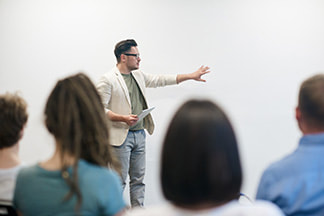|
Prensky (2010) recommended partnering with students and defined partnering as the way of working together to produce and ensure student learning in the 21st century. Partnering includes the roles of the teacher as coach and guide, goal setter and questioner, learning designer, control shifter, context provider, and rigor provider. He later added to the definition by saying that the teacher’s goal of partnering is not to tell (the answer), and here is how it works.  How do you plan for the effective use of technology in your lesson design? How do you plan for the effective use of technology in your lesson design? LEARNING TOGETHER In the partnering pedagogy, Prensky stated that it is the job of the student to use technology as the teacher coaches and models the use of technology for effective learning. For this to occur Prensky recommended teachers focus on things they already do but develop a deeper level of expertise in questioning, rigor, and feedback for students. This begs the question, what and how should I integrate technology into my teaching? Determining how technology will allow students to arrive at learning outcomes during the design phase of the lesson should guide planning. Fullan (2013) emphasized that technology and pedagogy should revolve around the roles of both students and teachers, while Sheninger (2016) iterated that students must always be at the center of the process when using technology for learning. Tamim, Bernard, Borokhovski, Abrami, and Schmid (2011) found that technology integration has the best effect when it is used to support student learning in the outcome rather than being used as a method for direct instruction. Determining how technology will allow students to arrive at learning outcomes during the design phase of the lesson should guide planning. Focusing on pedagogy first and technology second will ensure effective technology implementation (Sheninger, 2016) and allow your students to appropriately utilize technology to demonstrate their knowledge and skills to a local and global audience.  Are your students at the center of the learning process when using technology for learning? Are your students at the center of the learning process when using technology for learning? USING TECHNOLOGY TO DEMONSTRATE LEARNING Tamim et al. (as cited in Lee et al., 2013) found that technology was best used for basic skills and factual learning, a necessary step for students to be able to use technology at a deeper level such as demonstrating their knowledge by creation of projects. The authors argued that the cognitive outcome identified, project-based learning, produced the highest effect in learning because it helped learners to see the part/whole relationship, and it inspired students to locate information, seek out facts, modify findings, and collaboratively work with their peers. Student cognitive outcomes can be increased by having students (a) collaborate in small or paired groups with computers, (b) develop instructional elements that are sense-making in context, and (c) and build student basic skills and help them see the interconnectedness of subject knowledge in a project-based learning (Lee et al., 2013, p. 140). For example, as the designer of instruction your practices might include:
 Challenge your students to demonstrate their knowledge and skills by incorporating technology into the outcome. Challenge your students to demonstrate their knowledge and skills by incorporating technology into the outcome. In conclusion, technology integration should be based upon student outcomes while keeping the focus of teaching to the verb. Research suggests placing an emphasis on what students can do with their knowledge, aligning teacher pedagogies with collaborative projects that spark the interest of the students, and moving the teacher away from the role of the knowledge expert to a facilitator who partners in learning with the students as successful ways to integrate technology in the classroom. Below are the resources mentioned from today’s post should you want to learn more about the successful integration of technology. In the meantime let us know how you are partnering in learning with your students in the comments below. If you found this post useful please join our Pedagogize It community and subscribe for free strategies for how to best use technology for learning. The Pedagogize It community revolves around what matters most, and that is you and the work that you do.
0 Comments
Your comment will be posted after it is approved.
Leave a Reply. |
 RSS Feed
RSS Feed